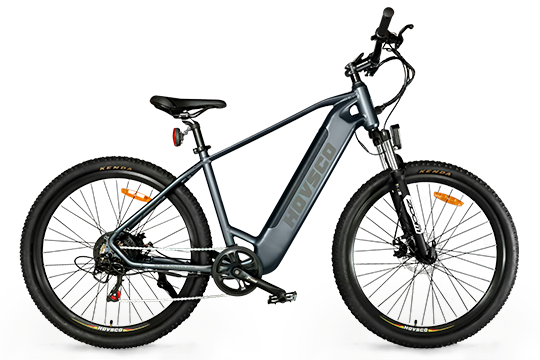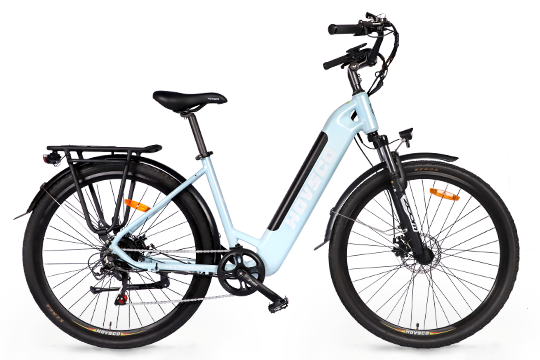E-bike Batteries: Everything You Need to Know

It is important to understand what you want from your electric bike before choosing a bike with the battery power that you need. You should have a battery that can satisfy your riding needs so that you will never have to worry about your e-bike running out of charge. As batteries are often one of the more expensive components of an electric bike, it makes sense that as the bike's price increases, the battery size should also increase.
Larger batteries provide you with more range on a single charge, of course. Even so, it also prolongs the battery's lifetime by reducing the number of charge cycles, which over time diminishes the battery's overall capacity. In terms of battery brands, Shimano and Bosch tend to manufacture the batteries for their own e-bike drive systems, whereas some more value-oriented brands, such as XDS and Velectrix, integrate Panasonic batteries with third-party suppliers to achieve their desired performance.
What are the composites of ebike batteries?
Most electric bikes in the United Kingdom are equipped with Lithium-Ion (Li-Ion) or Lithium-Polymer (LiPo) rechargeable batteries. On the other hand, lead-acid batteries are still the most common type of battery in China.
Due to issues with quality and weight, lead-acid batteries are not widely used around the world. Acid lead batteries, for example, make up less than one percent of the market in Europe. Lithium-ion batteries account for 96.5 percent, while lithium-polymer batteries account for two percent.
Specifically, battery packs consist of multiple cells: the lead-acid cells are similar to those used in automobiles, while the lithium cells are similar to those used in smartphones. Apart from the chemical composition of their cells, the primary difference between lead-acid and lithium batteries is their size: lead-acid batteries are large and heavy and have a short life (200 to 300 charge cycles), while lithium batteries are smaller and can last for a longer period of time (from 500 to 1,000 charge cycles).
Although Li-Ion batteries are being further developed, Li-Po batteries are less expensive and smaller than Li-Ion batteries. They are highly brittle, and their service charge is uncertain.
How Long Does the Battery of an Electric Bike Last?
An e-bike battery may provide pedal assist for up to 100 kilometers on a single charge, depending on the model. You may also need to consider how hard you pedal, the geology of the terrain you cycle on, and even whether the wind is at your back or against you.
The batteries for electric bikes have a long life span and can withstand hundreds or thousands of recharge cycles, so you can expect years of dependable service before they need to be replaced.
Tips for getting the most range and longevity out of your battery.
Regardless of whether you're new to e-biking or a seasoned expert, you may benefit from a few brief tips on extending the range and life of your battery.
Batteries play a critical role in the operation of any electric bike, providing power for smooth uphills and flat-out single-track blasts. However, the parameters that affect the tire's power when it touches the soil and its durability over time are less clear.
- Make use of the appropriate model at the appropriate time.
Let me start by stating the obvious: if you ride in turbo mode all day (no pun intended), you will not last long. Cycle through the bike's many modes for extended periods of time (a few hours or more) to maximize efficiency and enjoyment. Ride on the lower and mid settings on roads, connections, and speedier trails (the names of the modes and settings may differ from system to system), boost the turbo for tricky and uphill sections, and limp home after long days of riding... (Some systems display power output values on the screen, although these may be difficult to read while navigating difficult terrain.)
- Lose a few pounds
Probably the most important factor in determining range is the weight of the rider and the bike. While there is no quick fix for the rider's most significant weight, eliminating excess weight from your bag and bike will help. During climbs when the engine and batteries exert considerable effort to propel the rider forward (as opposed to flat rides where they are only working to maintain speed), the difference is particularly noticeable. A lighter rider will always get more mileage from a charge, regardless of weight.
- Make use of the proper tires.
Rolling resistance is another important factor in determining how far a battery charge will last. Tire compound, width, tread pattern, and pressure all affect this. Choosing the right tires for your riding style is essential, but you should experiment with different tire pressures to find the right balance. Lower pressures will reduce rolling resistance, but they will also impair bike control. In addition, certain solid and semi-solid tire inserts are finding their way into e-bikes (to prevent punctures), which may reduce range due to increased rolling resistance.
- Explore a range of terrain types.
Flowing curves and gentle slopes can drain your battery in fewer kilometers than many strong hills or technical singletrack, so plan accordingly. Due to the slower pace, it is sometimes ideal to quantify the trip in terms of time spent on the bike (and enjoyment factor!) rather than distance traveled...
- Maintain a smooth pedal stroke.
A decent, smooth pedaling technique will improve range significantly. Rather than pounding the pedals, spin your feet rather than pound them, and choose appropriate gear ratios for the terrain - low gears for steep climbs put less strain on the engine and batteries.
- Make sure you ride smoothly as well.
It's time to refine your riding technique now that you've mastered your pedaling technique. Rather than slamming into corners, pausing, and reapplying, the brakes flow through turns. Accelerating from zero strains the battery's capacity.
- Avoid allowing the battery to get too cold.
Low temperatures would reduce the range of a single battery charge, but according to battery specialists Bosch's literature, lower temperatures will increase the range of a single battery charge.






Leave a comment